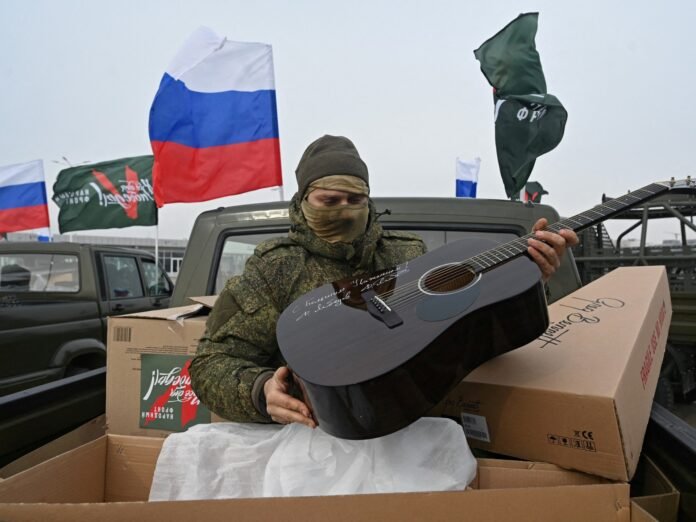Kyiv, Ukraine – A flight from Moscow to the Pacific port of Vladivostok takes almost nine hours – a domestic flight that covers two-thirds of Russia’s span between the Baltic and the Pacific.
There are about 10,000 kilometres (6,200 miles) from east to west in Russia, which is 17 million square kilometres (6.6 million square miles), comprising 11 percent of the Earth’s landmass – a bit more than the areas of China, India, Indonesia and Saudi Arabia put together.
Even though two-thirds of it is permafrost, the sheer vastness used to save Russia from invasions, be it Napoleon’s Grand Army in 1812 or the 3.8 million soldiers of Nazi Germany and its allies in 1941.
However, as the war with Ukraine, a former province whose Cossack armies once spearheaded czarist conquests, grinds into its fourth year, Russia’s size has become a liability.
“Russia’s territory offers maximal capabilities for strikes,” Lieutenant General Ihor Romanenko, former deputy chief of Ukraine’s general staff of armed forces, told Al Jazeera sarcastically.
Ukrainians – from top brass to civilian volunteers assembling drones in their garages – rewrite the rules of warfare and write off Russia’s obsolete stratagems.
These days, Kyiv proves daily that the border between Russia and Ukraine that stretches almost 2,000 kilometres (1,230 miles) is penetrable in both directions.
It carved out toeholds in two western Russian regions – Kursk and Bryansk – that distract tens of thousands of servicemen.
Meanwhile, Moscow’s Soviet-era air defence systems, designed to intercept NATO missiles, are spread too thin across western Russia and often prove helpless against increasingly sophisticated Ukrainian drone attacks.
“If a group of people is professional and motivated enough, it’ll always find a way to achieve a goal, and that’s something the SBU proved,” Romanenko said, referring to the Ukrainian Security Service, the main intelligence agency that has conducted dozens of stings in Russia.
On June 1, the SBU executed Operation Spiderweb, a massive drone attack that reached Siberia for the first time since the full-scale invasion began in 2022.
Ukrainian drones – possibly smuggled from Kazakhstan – flew out of a truck near the Belaya airbase in the Irkutsk region, almost 4,000 kilometres (2,500 miles) east of the Ukrainian border, to destroy or damage several strategic bombers.
The same sting targeted bombers in the Amur region, 7,500 kilometres (4,660 miles) east of Ukraine, and only a technical glitch saved the bombers on the Ukrainka (“Ukrainian woman”) airstrip.
The sting “is a lesson that military bases, in warzones and at home, are now more vulnerable than ever to cheap, easily hidden and quickly deployed weapons that can appear with little notice,” Mick Ryan, a retired Australian general and fellow at the Lowy Institute, a military think tank in Sydney, wrote.
The scale and boldness of Kyiv’s campaigns on Russian soil follow humiliating defeats.
Moscow was emboldened by the 2014 annexation of Crimea, when Ukrainian troops and police were ordered to surrender government buildings and military bases without firing a single shot – and many joined the occupants.
Weeks later, Moscow-backed separatists seized a third of the southeastern Donbas region and pushed out Ukrainian forces.
So, in 2022, Moscow expected a blitzkrieg, and the thought of defending its own territories may not have occurred to Russian President Vladimir Putin and his top brass.
“They didn’t think about it at all, they didn’t plan a long operation,” Volodymyr Fesenko, head of the Kyiv-based Penta think tank, told Al Jazeera. “Moscow didn’t expect Ukraine to resist for so long and to strike back on Russian territories so effectively.”
Moreover, Ukrainian drones target sites in Moscow and the surrounding region, where many military plants and bases are concentrated.
In May 2023, two Ukrainian drones exploded over the Kremlin slightly damaging one of the palaces.
Two years later, swarms of Ukrainian drones buzz over Moscow suburbs regularly.
“I cherish nights without air raid sirens,” a woman who requested anonymity and lives southwest of Moscow told Al Jazeera.
Civilian flights are delayed or cancelled in western Russia so often that some travellers take a train to airports in northern Kazakhstan.
Apart from hitting military sites, Ukraine began targeting the backbone of Russia’s economy.
Dozens of strikes on oil refineries and pipelines disrupted almost a sixth – 14 percent – of Russia’s oil refining capacity, the Pentagon’s defence intelligence agency said in mid-May.
A response to Russia’s campaign to destroy Ukraine’s energy infrastructure, the strikes prompted a six-month ban on petrol exports, drove up domestic fuel prices by 30 percent and triggered the import of petrol from neighbouring Belarus.
The attacks were so devastating that Washington bristled at Kyiv for driving up global oil prices.
Kyiv also exploits Russia’s over-reliance on railroad supply lines in a country of notoriously potholed roads.
On May 30, two bridges collapsed in the Kursk and Bryansk regions in western Russia, causing two trains to derail, killing seven and wounding 69 people.
Moscow blamed Ukraine and called the explosions “terrorist attacks.”
Some analysts, however, say that Kyiv’s strikes on Russia are too belated, insufficient and unfocused to cause serious damage.
Ukraine “has long ignored outdoor ammunition depots but symbolically and senselessly struck Moscow,” Nikolay Mitrokhin, a researcher with Germany’s Bremen University, told Al Jazeera.
When it did start hitting the depots and airbases, Russia responded by building hangars and relocating planes to even more remote airfields, he said.
“The main question is what Ukraine can destroy without the possibility of restoring, or will lead to huge one-time losses for Russia,” he said. “And that’s where I don’t see real successes.”
But retired general Romanenko thinks that the real successes lie ahead.
“We lack tools,” he said, referring to Ukrainian-made missiles and more sophisticated drones that are yet to be mass-manufactured. “Once we have the tools – Putin will be more realistic, for he only understands force.”






